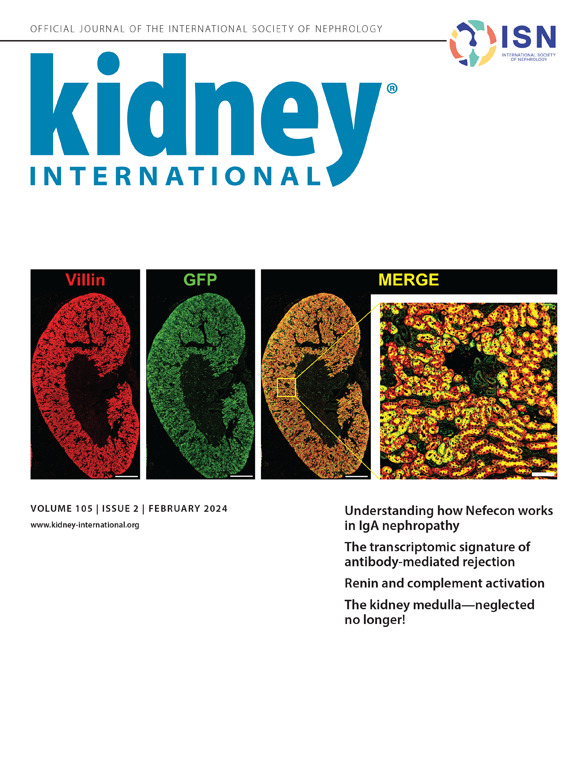透析液钾浓度为 3.0mEq/l 加上环硅酸锆钠对无透析天数的影响与透析液钾浓度仅为 2.0mEq/l 对高钾血症血液透析患者心律失常发生率的影响。
IF 14.8
1区 医学
Q1 UROLOGY & NEPHROLOGY
引用次数: 0
摘要
管理血清钾和血液透析液钾浓度的最佳方法尚不确定。为了研究这个问题,对接受血液透析三个月或更长时间、患有高钾血症(透析前血清钾 (sK+) 5.1-6.5 mEq/l)的成人植入了心脏监护仪,并随机接受了为期八周的 2.0 钾/2.5 钙 mEq/l 不含环硅酸锆钠(SZC)的透析液(2.0 钾/2.5 钙 mEq/l)治疗。5 mEq/l 不含环硅酸锆钠 (SZC) 的透析液(2.0 钾/无 SZC)或在非透析日使用 3.0 钾/2.5 mEq/l 含 SZC 的透析液(3.0 钾/SZC),以维持透析前 sK+ 4.0-5.5 mEq/l,然后再交叉治疗八周。主要结果是持续时间为 2 分钟或以上的裁定心房颤动 (AF) 发作率。次要结果包括有临床意义的心律失常(心动过缓、室性心动过速和/或心搏过速)以及 sK+ 测量值在 4.0-5.5 mEq/l 最佳窗口范围内的比例。88 名参与者(平均年龄:57.1 岁;51% 为男性;透析前 sK+ 平均值:5.5 毫摩尔/升)的随访时间为 25.5 人年,其中 9 名患者检测到 296 次房颤发作。3.0 钾/SZC 与 2.0 钾/无 SZC 相比,未经调整的房颤发生率较低;9.7 与 13.4/人-年(模型率比 0.52;95% 置信区间:0.41;0.65)。3.0 钾/SZC 与 2.0 钾/noSZC 相比,临床上明显的心律失常减少了 6.8 对 10.2/人-年(模型比率比为 0.47:0.38;0.58)。使用 3.0 钾/SZC 时,在最佳窗口期外测量 sK+ 的次数较少(模型比率:0.27:0.12, 0.35)。使用 3.0 钾/SZC 与使用 2.0 钾/NoSZC 相比,低钾血症发生率较低(33 对 58 例患者)。因此,对于接受维持性血液透析的高钾血症患者,与钾2.0/无SZC相比,在非透析日联合使用钾3.0 mEq/l和SZC可降低房颤、其他临床意义的心律失常和透析后低钾血症的发生率。本文章由计算机程序翻译,如有差异,请以英文原文为准。

Effects of dialysate potassium concentration of 3.0 mmol/l with sodium zirconium cyclosilicate on dialysis-free days versus dialysate potassium concentration of 2.0 mmol/l alone on rates of cardiac arrhythmias in hemodialysis patients with hyperkalemia
The optimal approach towards managing serum potassium (sK+) and hemodialysate potassium concentrations is uncertain. To study this, adults receiving hemodialysis for three months or more with hyperkalemia (pre-dialysis sK+ 5.1–6.5 mmol/l) had cardiac monitors implanted and were randomized to either eight weeks of 2.0 mmol/l potassium/1.25 mmol/l calcium dialysate without sodium zirconium cyclosilicate (SZC) (2.0 potassium/noSZC) or 3.0 mmol/l potassium/1.25 mmol/l calcium dialysate combined with SZC (3.0 potassium/SZC) on non-dialysis days to maintain pre-dialysis sK+ 4.0–5.5 mmol/l, followed by treatment crossover for another eight weeks. The primary outcome was the rate of adjudicated atrial fibrillation (AF) episodes of at least 2 minutes duration. Secondary outcomes included clinically significant arrhythmias (bradycardia, ventricular tachycardia, and/or asystole) and the proportion of sK+ measurements within an optimal window of 4.0–5.5 mmol/l. Among 88 participants (mean age: 57.1 years; 51% male; mean pre-dialysis sK+: 5.5 mmol/l) with 25.5 person-years of follow-up, 296 AF episodes were detected in nine patients. The unadjusted AF rate was lower with 3.0 potassium/SZC versus 2.0 potassium/noSZC; 9.7 vs. 13.4/person-year (modeled rate ratio 0.52; 95% confidence interval 0.41–0.65). Clinically significant arrhythmias were reduced with 3.0 potassium/SZC vs. 2.0 potassium/noSZC (6.8 vs. 10.2/person-year modeled rate ratio 0.47; 0.38; 0.58). Fewer sK+ measurements outside the optimal window occurred with 3.0 potassium/SZC (modeled odds ratio: 0.27; 0.12–0.35). Hypokalemia was less frequent (33 vs. 58 patients) with 3.0 potassium/SZC compared with 2.0 potassium/noSZC. Thus, in patients with hyperkalemia on maintenance hemodialysis, a combination of hemodialysate potassium 3.0 mmol/l and SZC on non-hemodialysis days reduced the rates of AF, other clinically significant arrhythmias, and post-dialysis hypokalemia compared with hemodialysate potassium 2.0/noSZC.
求助全文
通过发布文献求助,成功后即可免费获取论文全文。
去求助
来源期刊

Kidney international
医学-泌尿学与肾脏学
CiteScore
23.30
自引率
3.10%
发文量
490
审稿时长
3-6 weeks
期刊介绍:
Kidney International (KI), the official journal of the International Society of Nephrology, is led by Dr. Pierre Ronco (Paris, France) and stands as one of nephrology's most cited and esteemed publications worldwide.
KI provides exceptional benefits for both readers and authors, featuring highly cited original articles, focused reviews, cutting-edge imaging techniques, and lively discussions on controversial topics.
The journal is dedicated to kidney research, serving researchers, clinical investigators, and practicing nephrologists.
 求助内容:
求助内容: 应助结果提醒方式:
应助结果提醒方式:


